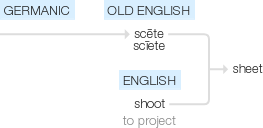Sheet
Old English scēte, scīete, of Germanic origin; related to the verb shoot in its primary sense ‘to project’.
wiktionary
From Middle English schete; partly from Old English sċīete(“a sheet, a piece of linen cloth”); partly from Old English sċēata(“a corner, angle; the lower corner of a sail, sheet”); and Old English sċēat(“a corner, angle”); all from Proto-Germanic *skautijǭ, *skautaz(“corner, wedge, lap”), from Proto-Indo-European *(s)kewd-(“to throw, shoot, pursue, rush”). Cognate with North Frisian skut(“the fold of a garment, lap, coattail”), West Frisian skoat(“sheet; sail; lap”), Dutch schoot(“the fold of a garment, lap, sheet”), German Low German Schote(“a line from the foot of a sail”), German Schoß(“the fold of a garment, lap”), Swedish sköt(“sheet”), Icelandic skaut(“the corner of a cloth, a line from the foot of a sail, the skirt or sleeve of a garment, a hood”).
etymonline
sheet (n.1)
Old English sciete (West Saxon), scete (Mercian) "cloth, covering, towel, shroud," from Proto-Germanic *skautjon-, from *skauta- "project" (source also of Old Norse skaut, Gothic skauts "seam, hem of a garment;" Dutch schoot; German Schoß "bosom, lap"), from PIE root *skeud- "to shoot, chase, throw."
Sense of "piece of paper" first recorded c. 1500; that of "any broad, flat surface" (of metal, open water, etc.) is from 1590s. Of falling rain from 1690s. Meaning "a newspaper" is first recorded 1749. Sheet lightning is attested from 1794; sheet music is from 1857. Between the sheets "in bed" (usually with sexual overtones) is attested from 1590s; to be white as a sheet is from 1751. The first element in sheet-anchor (late 15c.) appears to be a different word, of unknown origin.
sheet (n.2)
"rope that controls a sail," late 13c., shortened from Old English sceatline "sheet-line," from sceata "lower part of sail," originally "piece of cloth," from same root as sheet (n.1). Compare Old Norse skaut, Dutch schoot, German Schote "rope fastened to a sail."
This probably is the notion in phrase three sheets to the wind "drunk and disorganized," first recorded 1812 (in form three sheets in the wind), an image of a sloop-rigged sailboat whose three sheets have slipped through the blocks are lost to the wind, thus "out of control." Apparently there was an early 19c. informal drunkenness scale in use among sailors and involving one, two, and three sheets, three signifying the highest degree of inebriation; there is a two sheets in the wind from 1813.
It must not be wondered at that the poor, untutored, savage Kentuckyan got "more than two thirds drunk," that is, as the sailors term it, three sheets in the wind and the fourth shivering, before the dinner was ended. [Niles' Weekly Register, May 2, 1812]
